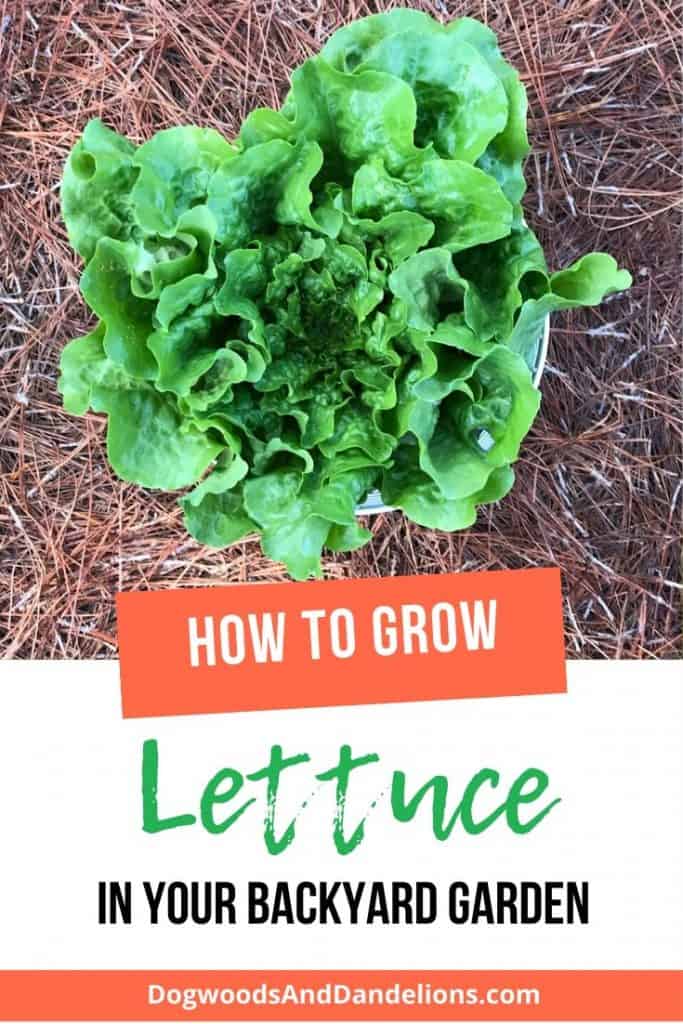How to Grow Lettuce
If you’ve never tried growing lettuce at home, you really should. Lettuce is a spring or fall crop that is relatively easy to grow.
It’s a perfect vegetable for beginning gardeners because it grows fast and tastes great. It tolerates poor dirt and can even be grown in containers.
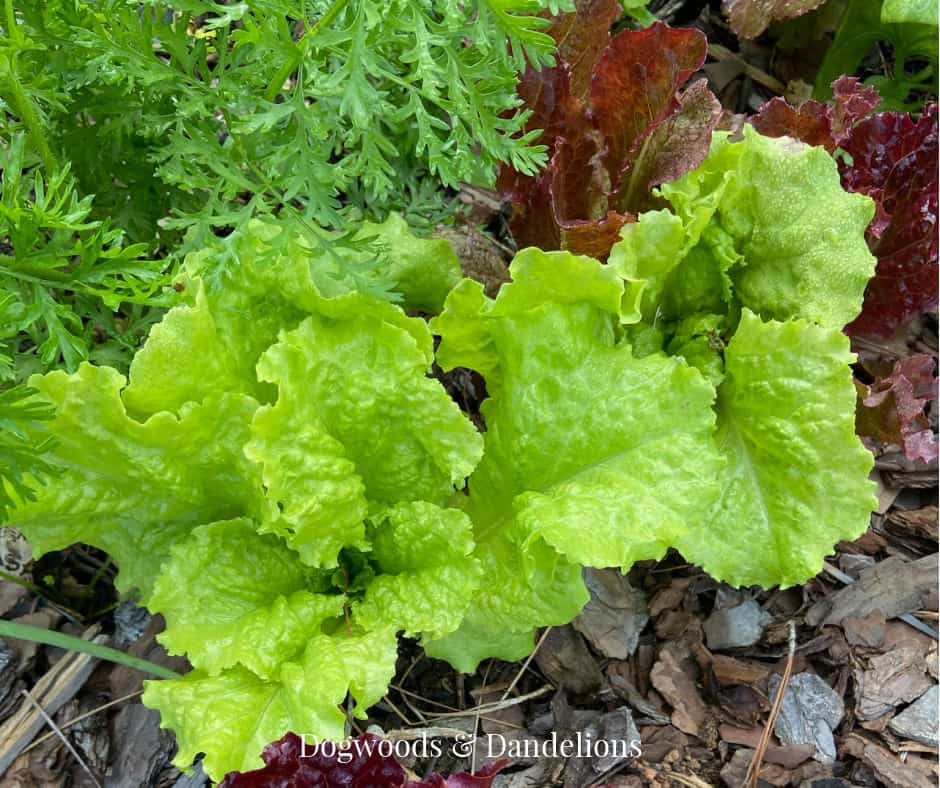
Affiliate Disclosure: Please note that some of the links in this article may be affiliate links and I may receive a small commission if you purchase something through a link. It will not change your cost. As an Amazon Associate, I earn from qualifying purchases. For more information, see my disclosures page.)
Benefits of Growing Lettuce
- Lettuce is one of the easiest spring crops to grow.
- There are so many wonderful varieties of lettuce that you just can’t buy at the store.
- You can grow many heads of lettuce for the price of one at the store.
Types of Lettuce
There are 4 types of lettuce – loose leaf, butterhead, crisphead, and romaine.
Loose-leaf lettuce is great for the beginning gardener. You can begin harvesting a few leaves as soon as the outer leaves are big enough to eat and you can keep harvesting over a long period of time.
There are so many wonderful varieties to choose from. (I share my favorites below.) Leaf lettuce comes in green, red, and spotted varieties and the leaves can vary from large frilly leaves to smaller ones shaped like oak leaves.
Butterhead lettuce forms a small, loose head. This type of lettuce is often found in clam-shell packaging at the grocery store and is often labeled as “artisan lettuce.” There are both red and green varieties of butterhead.
Crisphead or Iceberg lettuce is the most common type of lettuce. Most varieties form tight heads and are crisp and sweet. Crisphead types need consistent moisture or the heads may crack, so it is not my first choice for new gardeners.
Romaine lettuce (also called Cos) forms dense, upright heads and is the main ingredient in Caesar salads. Romaine lettuces can be planted a little more closely together since the heads don’t spread out as much as other types.
How to Plant Lettuce

Lettuce does best in cool weather, about 60-70 degrees, so it should be planted in early spring or in the fall. As the weather gets too hot, lettuce will start to bolt (grow a seed head) and turn bitter.
Lettuce can be grown from seed or from transplants. If this is your first garden, I recommend starting with transplants. Sometimes starting lettuce indoors leads to spindly plants unless you have a grow light.
I find starting lettuce directly in the garden easier than starting it indoors, but you do have to keep the seeds moist while they germinate. (This means daily watering, sometimes twice a day if it is sunny and warm.)
If you want to start lettuce indoors, start the seeds about 3-4 weeks before transplanting them outdoors. I like to start my seeds in Jiffy pellets. Place 2-3 seeds in each pellet and just barely cover the seeds with soil.
Keep the soil consistently moist and place lettuce seedlings under a grow light as soon as they start to germinate. Be sure the grow light remains about 2″ above the plants.
Once the plants are about two weeks old, thin seedlings by snipping off all but the healthiest plant in each pellet. Transplant in the garden when they are about 3 or 4 weeks old.
If starting lettuce outdoors, choose a sunny spot in your garden that receives 6-8 hours of direct sunlight each day. Lettuce prefers loose, well-drained soil. While lettuce can tolerate some shade, it will grow fastest in full sun.
The biggest issue with direct seeding lettuce in garden beds is keeping the soil consistently moist. If the soil is allowed to dry out, the seeds will have a difficult time germinating.
When planting seeds outdoors, direct sow seeds in rows or sprinkle the seeds over the growing area. One packet of lettuce seeds will usually plant a large area. (You can also save some of the seeds for a second sowing in a couple of weeks.)
Just barely cover the lettuce seeds with a fine layer of soil. Planting too deep will not allow the seeds the germinate as they need a bit of light to start growing.

Lettuce is a cool-season crop so it can take some light frost. It can be planted outdoors before your last frost date in the spring.
Lettuce also makes a great fall vegetable if planted in late summer, about 4-8 weeks before your first frost. It can be grown in a cold frame most of the year in some climates.
Lettuce needs consistent moisture to grow well. Plan to keep it watered if you have a dry spell. Regular moisture will also keep head lettuce from splitting and leaf lettuce from bolting as quickly.
Adding a shade cover over your lettuce can also keep it from going to seed as quickly during hot weather.
If you are planting lettuce during the warmer days of late spring and early summer, you can sometimes prolong the harvest by planting it on the north side of a taller crop like beans or tomatoes. The taller plants will provide some partial shade to keep the lettuce cooler for a bit longer.
Planting lettuce several different times during the spring can extend your harvest by several weeks. Succession planting will also allow you to get a continuous harvest of lettuce all through the growing season.
And mulching around your lettuce will help keep the roots cool and allow you to get an extra couple of weeks of growth from your plants. This is especially important if you are planting in black plastic.
Lettuce also makes a great vegetable to grow in containers, especially if you can move the containers to a shaded area when the weather gets hot.
What to Plant with Lettuce
Lettuce can be inter-planted with radishes, carrots, beets, and even strawberries. If aphids are a problem planting garlic or chives among the lettuce seems to help deter them.
How to Harvest Lettuce
Loose leaf lettuce can be harvested very early. You can start picking the outer leaves for baby lettuces as soon as they are about 2″ long.
Loose-leaf lettuce types will continue producing leaves from the inside. Or you can cut the entire plant. Usually, the plant will regrow another set of leaves.
For crisphead lettuce, cut the entire head as soon as you are ready to eat it. Head lettuce can be cut even when small, though it won’t grow back another head.
To store any type of leafy greens, wash them well, and store them in a plastic bag or storage container with a paper towel or lint-free cloth to absorb excess moisture. Most salad greens will usually keep for 5-7 days if properly stored.
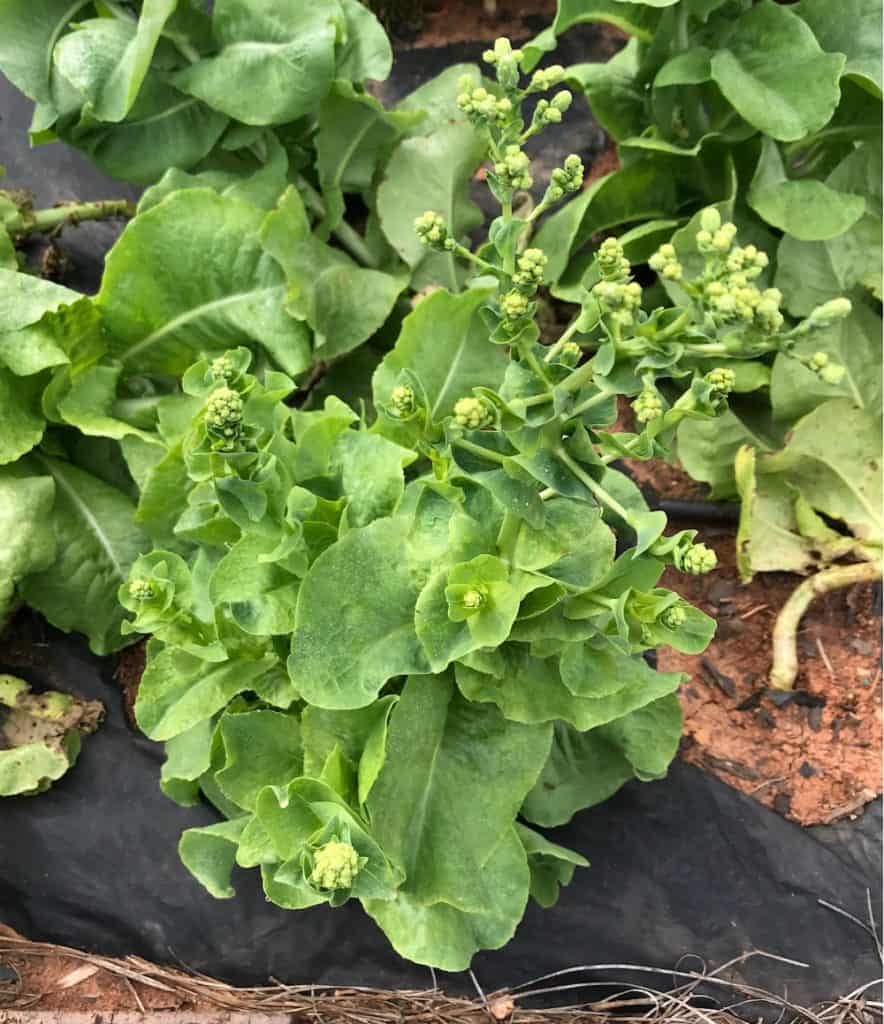
Once lettuce sends up a center stalk with flower buds on it, (see picture above) the lettuce is usually done. While not harmful to eat, it will usually be very bitter.
At that point, it’s time to pull it up and replace it with something else. (If you have chickens, you can throw the whole plant in the chicken yard. They really don’t care that it’s bitter.)
To eat your lettuce, you can use it just as you would any store-bought lettuce. Wash it well in a sink full of water or under running water. Spin it dry in a salad spinner. (I have this one and I love it!)
Top a sandwich with it, make lettuce wraps, or my favorite use, make salads with your homegrown lettuce. You can find out how to make a great salad here.
And for salad dressing ideas, my honey mustard dressing and my ranch dressing are both popular recipes. If you have an abundance of lettuce, my post on A Week of Main Dish Salads will help you use it all up.
Pests & Diseases
Lettuce is not usually plagued with too many pests. However, you occasionally will find aphids, slugs, or earwigs that are dining on your delicious greens.
Most of the time, you can wash these critters away but if slugs are your problem, a shallow dish of beer set in the garden will usually attract and drown them.
My biggest problem with lettuce has been the deer. Until I fenced my garden in, the deer would munch down the lettuce overnight.
Surprisingly, bunnies weren’t as big of a threat as the deer. The bunnies tend to eat other things such as peas and beans before my lettuce. For deer and bunny problems, I recommend placing a row cover over the lettuce if you can’t afford a good fence.
Diseases aren’t very common with lettuce, except for the occasional fungal disease if the weather is extremely wet. This is another reason lettuce is so easy for a beginner to grow.
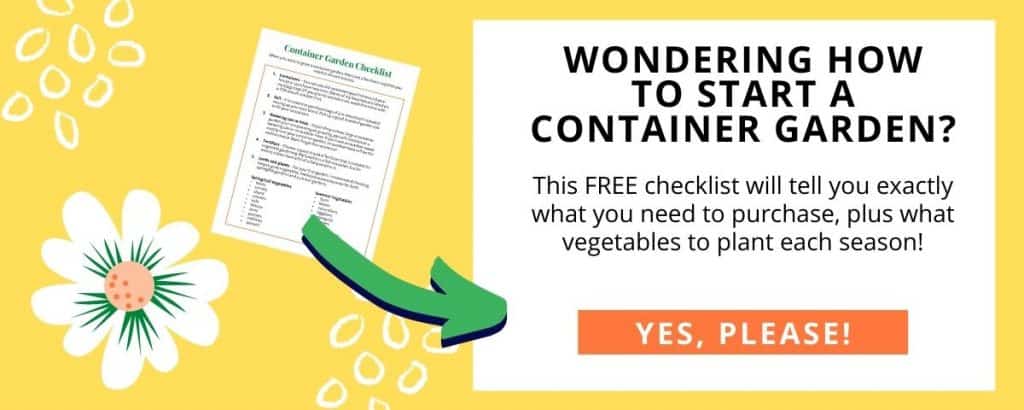
Favorite Varieties of Lettuce
There are so many wonderful varieties of lettuce it was very hard for me to choose my favorites. But I narrowed it down to this list. I hope you’ll try some of these lettuce varieties in your garden too.
Loose-Leaf Lettuce
I love Black Seeded Simpson lettuce. It is the first variety I remember growing. It is an early lettuce with a good heat tolerance. For those that prefer heirlooms to hybrids, Black Seeded Simpson lettuce is an heirloom.
This is a popular loose-leaf lettuce variety with good tolerance to heat so it won’t bolt as quickly as some other varieties. You can usually locate seeds for this variety at almost all home and garden centers.
Green Ice is another favorite variety. It has crisp leaves on a compact plant with crinkly leaves. This is a great variety to plant if you don’t have a lot of garden space.
Red Sails lettuce is a beautiful lettuce to grow. The outer leaves are a bronze-red color, but the color turns green toward the inside.
It is an early lettuce and you can harvest full size heads in about a month and a half. This variety looks great in a salad, especially when mixed with an all green variety.
Butterhead (Bibb) Lettuce
Buttercrunch is a compact variety with a buttery texture. The leaves are crisp and sweet and it is slow to bolt during the heat.
Tom Thumb produces mini sized heads which are perfect for a single salad. Because of its small size, it resists bolting better than larger kinds. This would be the best of the butterhead varieties for a small garden.
Crisphead
Iceberg is the most common type of crisphead. This is the classic head lettuce you find in the grocery store. It can be more difficult to grow than other kinds and you need to cut the whole head at one time instead of picking a few leaves along the way.
With so many other wonderful varieties of lettuce, the crisphead type isn’t one I would make a lot of room for in a small garden. But if you adore crisphead lettuce, Iceberg is the variety I would choose.
Romaine
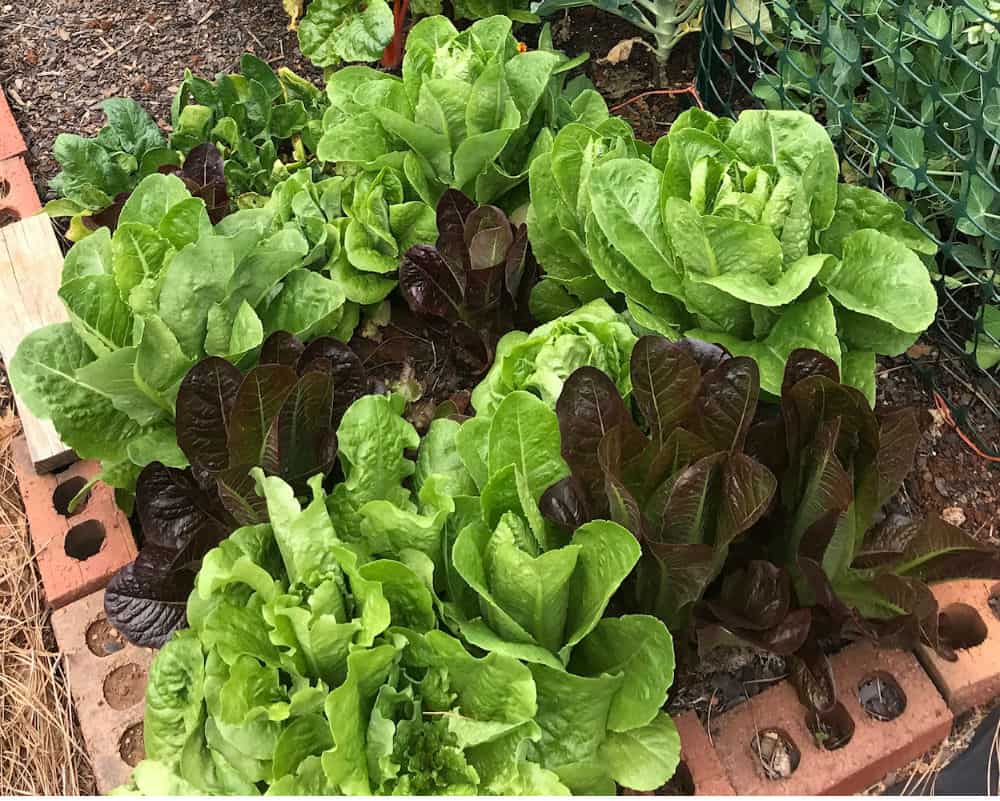
Little Gem is a miniature romaine that is great for small spaces like a square foot garden. This variety is an heirloom favorite with a good tolerance to heat.
Freckles is a beautiful lettuce to grow. This romaine has green leaves with burgundy blotches or “freckles,” hence the name. I love this lettuce as the base for a simple salad that lets the beauty of the leaves shine.
Jericho is a large romaine with a crisp head and good disease resistance. It was bred for high heat so it does well in the south, even into the early summer. This is by far, my favorite romaine to grow.
The Parris Island variety of romaine is slow to grow, but produces large heads with great flavor. I have had great success with this lettuce in my garden over the years.
What’s Your Favorite Variety of Lettuce
By now, you are probably asking yourself if I really have grown all these varieties of lettuce. Yes, yes I have. I have grown all these varieties and many more.
While I realize this is a lot of favorites, that’s probably because lettuce is one of my favorite things to grow. I have tried many kinds over the years and have truly enjoyed almost every one.
n the list above, I have linked to Amazon so you could see what the varieties look like, but as always, feel free to shop around or patronize your local garden center for the best prices.
Have you grown lettuce before? Do you have a favorite variety? Let me know in the comments. I love to try new things.
Related Posts:
- Have lots of shade in your garden? These vegetables will grow in the shade.
- How to grow vegetables in containers.
- How to start vegetables from seed.
